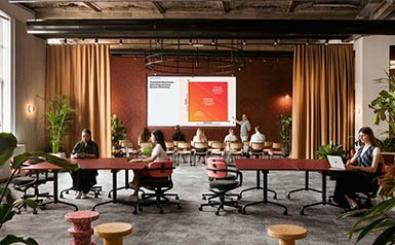“You are probably among the first 250 people in the country to try this,” says Max our German guide for the evening.
He lifts a sleek headband out of an equally sleek padded case, slips it over his head and starts tapping his finger and thumb together in front of his face. “There are only about 15 or 20 of them in the country – I flew out to New York to pick this up 5 weeks ago.” Grins of anticipation spread across the faces of my four fellow geeks. “And I believe, this is the most revolutionary device created in the past 5 years.”
So begins my Hololens experience – an evening run by Max’s company, an innovation studio, and a chance to get my hands on the new developer model of the flagship augmented reality device from Microsoft, an Edelman client.
The Hololens is equipped with four 3D scanners that fire infrared beams around the room. Like your brain, it remembers what you’ve recently looked at and additively builds a 3D spatial model of your surroundings. Our guide demonstrates the process through a live stream to a TV, enabled by the Hololens’ HD front camera. The device surveys us, and replicates the room in 3D polygons. Very Matrix.
After some theory, and a slightly silly lesson on how to point our fingers, we get to play. Max tightens the Hololens onto my head and asks me to look around the room. I can clearly see everything just as I had left it through the glass visor – so far, so normal. Then I spot something small in the middle of the board table we are sat around. I peer closer, and see a little weightlifter holding a little barbell set. I tap my finger and he springs to life, lifting his weights above his head. With another tap, I pick him up and move him around the table. I lift him up into the air and spin him around in front of my face. I set him down on the floor and move my fingers forward to make him grow. Suddenly, stood in front of me is a lifesize 3D hologram of a real man, teaching me the clean and jerk. I walk around him and stare in awe. Max hadn’t oversold the Hololens.
The surprisingly light device is its own computer, entirely untethered and running Windows 10. A number of speakers built into the band enable 3D sound. If you move around the room, the Hololens tracks where you are in relation to the holograms it is creating, and shifts the direction of the sound accordingly. As a fan of VR, it struck me immediately that this was an entirely inverse experience. Where virtual reality places you inside a new 3D environment, ‘mixed reality’ places 3D objects directly into your environment.
It immediately sets my brain whirring on the business applications for this fascinating technology. Designers and engineers can walk around their creations before they even exist. Theoretical training scenarios can be brought to life in safe but memorable interactive experiences. Minority Report-style control panels could be built for complex systems, from a smart city’s transport network to a company’s IT infrastructure. Remote communications could take on a whole new dimension – literally. Already, a Skype app for Hololens lets you draw 3D diagrams directly into the space in front of your caller’s eyes.
And of course for a marketing man, the communications implications are enticing. From the humble photo, to interactive graphics and video, visual storytelling has grown enormously in importance in our social and digital media age. If a picture paints a thousand words, imagine what live 3D visualisations could do to describe products, services, people, theories and data.
It’s early days still for the Hololens, and the hardware will continue to evolve. But to experience this next-generation experiment in AR is to imagine an economy and society transformed by its potential. And as a professional communicator, I spend much of my time encouraging clients to show, not just tell. Well, showing just got a whole lot cooler.




